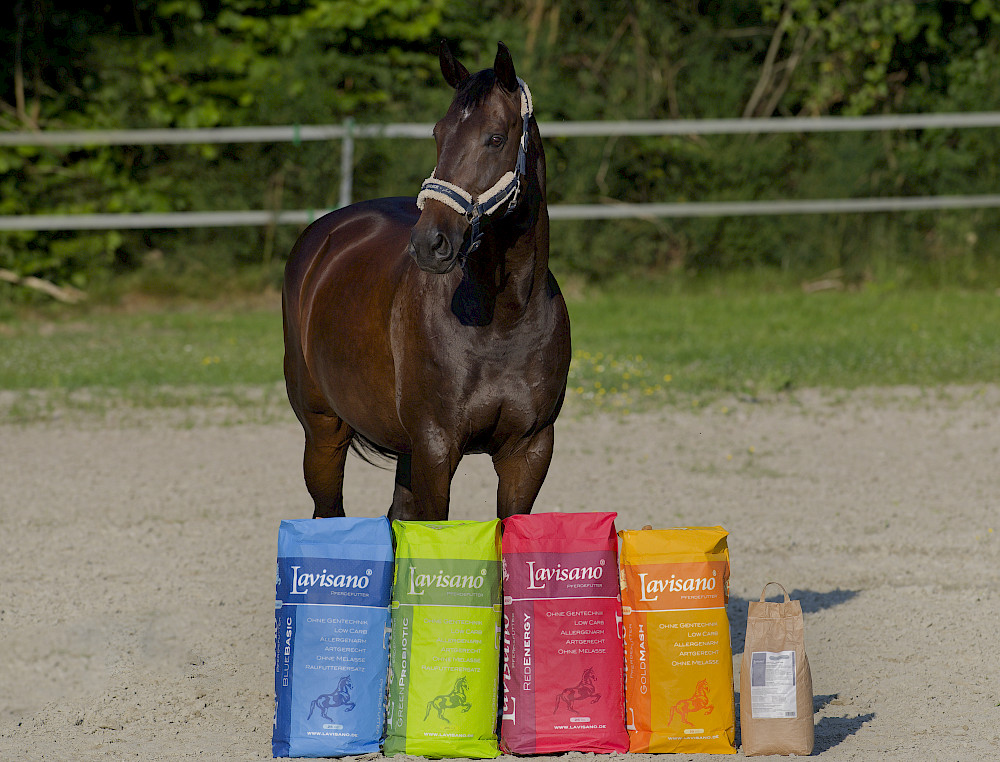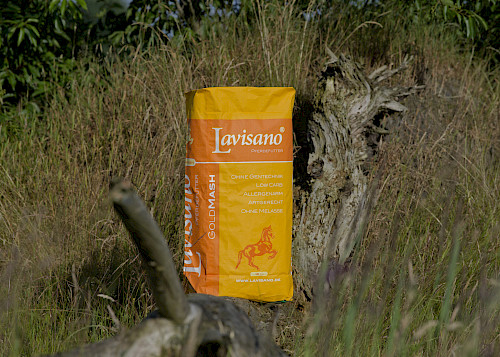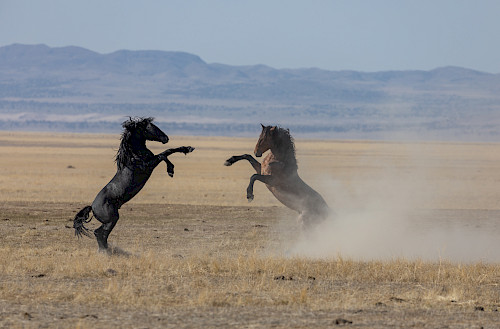“Owners who want to give their horses a natural and healthy diet should feed them as nature intended.”
Lavisano® not only provides important fibre components, essential fatty acids and amino acids, it also has a very low carbohydrate content (approx. 15%).
Lavisano® has high quality ingredients that provide the horse with the nutrients in the grasses and plants that wild horses originally ate.
Lavisano® is a complete feed. It contains everything a horse needs for a healthy metabolism.
Lavisano® can help to restore the intestine’s natural function of maintaining the right level of healthy intestinal flora. As a result, this natural diet can have a positive impact on health problems caused by a metabolic disorder
Lavisano® is specially formulated as an ethological feed that genuinely deserves the epithet of “natural”.
Products
Contains all the nutrients your horse needs for a healthy diet.
Background
Lavisano® was developed on the basis of our horses’ original diet and our knowledge of the specific and special aspects of the equine digestive system.
Distributor search

We have competent distributors in Germany, Austria and Belgium.
Use your post code to perform a quick and easy search for a distributor near you.
If you are interested in being a distributor, call us on +49 7150 3680598 or send an e-mail to info@lavisano.de.
find a retailerFAQ
the most important questions about Lavisano
To give you an insight into the effect Lavisano has in the intestine and why we believe that a natural feed is always the best choice for your horse, here’s a brief explanation.
Lavisano loosens old accumulations in the gut so that the horse can pass them naturally. This is essential to the horse’s intestinal health. It also ensures that any old feed residue is completely eliminated from the gut. In some cases, you will notice a strong odour, but this is a good sign that the intestine is being properly cleansed and can start healing. The organisms living in the intestinal flora are able to breathe again and recolonise the intestine.
Lavisano provides those organisms with their favourite meal: the right roughage. The type of roughage the horse eats makes a difference. The bacteria, protozoa and yeast living in the intestine need it for healthy growth and the horse needs them to stay well nourished. Unless they receive the right food, they waste away and die. And when that happens, their function of protecting the intestine is also lost, which often results in damage to the intestinal epithelium. Lavisano contains everything the intestinal floral need to survive and flourish.
Surely I can just feed hay? Many people have considered how to obtain the best possible quality hay. Which variety to sow, and when to cut it. There are many good concepts. Nevertheless, the grass we make our hay from grows here in central Europe, which means that its conditions are optimum. Within one single summer it grows, seeds and grows again two or three times. On the plains where the first horses lived, these conditions didn’t exist. Different types of grasses grow there that are more drought- and frost-resistant, and it also takes them longer to seed. In addition to that, some only have very short vegetation phases (Arctic circle), which means that they cannot regrow. During this time, they absorb high quantities of minerals and trace elements from the soil, they lignify more and contain substantially less sugar. These grasses are perfect for horses, but it’s impossible for us to feed our horses with those grasses, so we have to find another source.
That’s where Lavisano comes in. Its base constituents come to Germany from southern France, where the climate is hot and dry.
Lavisano uses no cheap fats or fortifiers such as sunflower seeds, apple or grape pomace or beet pulp. These fortifiers pose a much bigger problem for the horse’s digestive system than most people think, and the intestine is also central to the immune system. As explained, the horse’s intestine can only function optimally if the horse is fed natural roughage that isn’t contaminated with pesticides, fungicides or herbicides. Contamination of the roughage with substances like these puts a real strain on the intestine. Horses depend on the microbiome in their gut. Pesticides, fungicides and herbicides are sprayed on crops to protect the seeds and fruits from microbes, and these poisons can end up in the horse’s intestine via its feed, where they attack the microbiome that is central to its immune system health. Contaminated feed is a widespread problem these days. Despite legally prescribed controls we regularly hear about feed contamination scandals.
Lavisano applies the same quality standards as the food production industry and dispenses with as many feed industry products as possible.
What does nature prescribe? If horses are herbivores, does that mean they can eat all kinds of plants? We know that’s not true.
Horses were fed a healthy diet of roughage for hundreds of years. Then concentrated feed (muesli) arrived, and with it the ailments. A lot of misunderstandings are caused by comparing horse to humans. However, the things we humans need to be healthy can be the thing that make horses sick. Why does muesli make horses sick? What’s the point in it then? Why can some horses eat large quantities of concentrated feed and then suddenly aren’t able to anymore? Some horses that are in regular training can withstand the sugar bombs in their intestines for a long time. The glucose that the body gets from the sugar is a source of carrier for the cells. But there comes a time when the intestine cannot cope any more. Let us explain why sugar is so problematic for the horse’s intestine and how you easily can prevent it.
Many people now understand that sugar in the horse’s intestine is fatal, yet sick and elderly horses are still being given feed containing molasses, carob beans, carrots or sunflower seeds, cereal flour, corn flakes, sugar beet pulp, or completely absurd new inventions. Recently, we’ve even seen spelt being recommended for feeding, even though it is known to contain gluten - and gluten is not tolerated well by horses.
Carob seeds and carrots are generally considered to be healthy food, and that is true for humans. But they contain too much sugar for horses, which is why they have to be counted in addition to concentrated feed. The hidden sugar that they contain overloads the horses’ intestines.
These are some of the health problems associated with the wrong diet:
Obviously, every living creature needs food. The main constituents of food are protein, carbohydrate and fat. Other essential nutrients include vitamins, minerals and trace elements. However, what is the best mix of those elements and nutrients for a horse?
We already know what vital substances a horse needs to remain healthy. Despite this, people often make fatal basic mistakes that have a negative impact on their horse’s health. One of the most common mistakes is the choice of roughage. There are different kinds of protein, fat and carbohydrate and horses, in particular, are very sensitive to those differences. Sometimes the names of the feed constituents cause confusion. For example, we talk about essential fatty acids, beneficial proteins and easy-to-digest, non-fibre carbohydrates (NFCs).
The adjective ‘easy-to-digest’ is a misleading term because easy-to-digest doesn’t necessarily mean it’s good for the horse. NFCs include sugar, (molasses), fructan and flour. As most horse owners are aware, these are the parts of the feed that cause the most problems and horse intestines don’t find them easy to digest at all. Horses’ bodies aren’t designed to cope with this kind of carbohydrate. They need roughage! In other words, the ideal carbohydrates for horses are the long-chain ones, which are also called neutral detergent fibres (NDF) and hard to digest. They are so difficult to split that the body’s own enzymes in the small intestine are not able to perform the task. This job is performed further along by the inhabitants of the large intestine: the bacteria, yeast and protozoa that are the key to a natural, horse-friendly diet. So it’s important to take care of them. Only the feed that horses ate in their original natural environments will keep them fit, healthy and in balance. By that we mean the hard-to-digest carbohydrates found on sparse plains.
Lavisano is setting new standards in this respect. Whereas conventional feed products (concentrated feed) tend to contain sugar, Lavisano feeds follow nature’s example. With the right roughage, the intestine is able to give the horse exactly what it needs in the most natural way. We regularly hear people saying that horses are steppe animals… Wrong! Horses originated in the Dasht-e-Kavir desert in Persia (today Iran) and it’s definitely not a steppe. It’s a salt desert with sparse vegetation. Although the zebra is also an equine that lives on the edge of the African steppe, it’s not an animal that most of us would want to ride. The first ponies were found in the polar region, where winters last 7-8 months. These places of origin are a good indication of what horses need to eat.
Our horses’ ancestors lived in a very barren environment where it was a real challenge to find food. Only the experienced herds found the rare feeding grounds and they had to travel long distances to get there. That’s why modern-day horse intestines find it difficult to cope with ad libitum feeding concepts. They actually need pauses between meals so that their intestines can digest the food and to prevent acidosis. A healthy horse will always take breaks from eating at its own initiative. The length of those breaks is important. Even when the horse is healthy, they should not exceed 4 hours.
Lucerne:
Lucerne is the main ingredient in Lavisano. It grows in France in the same soil that produces the wonderful Champagne grapes. That soil is rich in minerals and very pure. However, the Lucerne isn’t simply cut and left to dry, it is brought in from the field fresh and processed by hand. The valuable Lucerne leaves are delicate and easily disintegrate, so they are stripped and gently dried in a clean air flow. This part of the Lucerne grass is particularly well tolerated by horses. Our Lucerne is also a far better source of well-tolerated protein for horses than cheap soy meal. It’s just a bit more expensive.
Horse hemp:
Hemp is a special ingredient in Lavisano. It has incomparable properties that not only support the horse’s intestinal health, but also improve the consistency and structure of the faeces. It is gentle on the intestine wall and prevents acidosis.
Bran:
Bran, which we described previously, is added to the feed without the grain for mineralisation. It also contains a high quantity of beta glucans which regulate blood fats.
Linseed:
Linseed has been an element of a healthy horse diet for centuries. It is a natural source of omega-3 fatty acids. But essential fatty acids can only be optimally assimilated by the body from the linseed if they are extruded.
Barley:
Finally, barley is a very special kind of cereal. It is the most easily digestible and contains the most nutrients, so it’s surprising that it has lost all significance in our modern diet. Barley is complex to process for human consumption and its lack of gluten makes it unsuitable for baking, so it has virtually disappeared from our diet and is almost exclusively found in animal feed. It was recently rediscovered as a ‘super food’ because a daily intake of 3g beta-glucans obtained from barley reduces the LDL level and the risk of cardiovascular disease. There are many different varieties of barley. The LAVISANO products naturally don’t contain feed barley! Only very small quantities of the variety that is suitable for human consumption are used.
All of our products are manufactured at the Raiffeisen feed factory in Kehl and contain no genetically modified ingredients whatsoever (www.rkw-kehl.de)!
The metabolic processes for easily digestible substances in the horse’s small intestine usually take 2-2.5 hours. This is where the quickly digestible concentrated feed components are broken down by enzymes.
The pancreas secretes proteases, lipases and amylases to break down carbohydrates, proteins and fats. Once these substances have been broken down in the acidic small intestine, they are absorbed into the blood system via the large body vein and are available for the organism.
The digested feed takes only 2-2.5 hours to pass through the small intestine. During this time, its pH value has to increase from 5.0 to at least 6.8.
If the horse is fed a carbohydrate-rich diet that promotes acidity and lactobacilli, the acidity is transferred into the caecum.
The function of the horse’s large intestine is to extract vital substances out of cellulose and other fibrous fractions of the feed. This “fermentation process” needs a very mild pH value of 6.8-7.0. During the “mashing process” the pH value can increase in a healthy intestine up to 7.2 and, in extreme cases, 7.4. The pH value can be measured in the faeces.
A pH value of less than 6.8 in the fresh dung means that the horse has an acidic large intestine.
This is the part of the gut (large intestine) where the horse produces vitamins, processes minerals and trace elements and produces metabolising amino acids and essential fatty acids.
The carbohydrates in the cellulose, hemicellulose and pectin are also converted in the large intestine. Intestinal symbionts (bacteria, virus, fungi) are essential to the proper function of the immune system. They are the basis for the nutrition of the organism.
Our hay is approx. 20-25% carbohydrate and sometimes more depending on where it was harvested. But the horse is naturally a grazer that eats a cellulose-based diet. So it needs a low-carb diet with less than 15% carbohydrates.
The more sugar and meal you feed the horse, the more acid its stomach produces. Therefore, the pH value in the stomach is also important.
If the large intestine is acidic, the intestinal symbionts that the horse’s metabolic system depends on cannot survive.
Lavisano® was developed on the basis of this knowledge. It was tested over a period of many years, which led to ground-breaking discoveries that encouraged us to market it commercially.
Lavisano pellets should generally be fed dry because the chewing process produces saliva, which is important for digestion.
However, it is possible to soak the pellets to make a mash.
Simply add warm or hot water to the desired amount of Lavisano (to cover the feed by approx. 1 finger’s width) and leave to stand for 10 minutes. Stir and then add lukewarm or cold water until the mash has the right consistency / heat.
You can also fortify the mash with the following:
● 2 handfuls of Lavisano
● 1 handful of crushed linseed
● 1 handful of oat hulls
Simply pour warm water over the top and leave to swell. When the mixture is lukewarm, add a teaspoon of hemp oil.
This is perfect for horses with teeth problems, for feeding medications, for controlled water consumption or simply as a treat.
Our feed products contain around 15-16% starch. (There are many different kinds of starch! The most frequently used type is a short-chain version / sugar. This is not added to Lavisano.)
Easily digestible carbohydrates account for 15.0% as compared to 20% and sometimes even 30% in German hay. 6kg of hay contains an average of 1kg sugar!
Lavisano’s natural sugar content is 3-4%.
If you are interested in distributing our products, or there is no distributor near you, write to us at info@lavisano.de.








